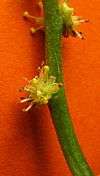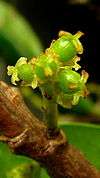Richeria grandis
Richeria grandis is a tree species in the family Phyllanthaceae which ranges from the Lesser Antilles to South America.[1]:687–688 The species is reputed to have aphrodisiac properties.[2]:105
| Richeria grandis | |
|---|---|
 | |
| Scientific classification | |
| Kingdom: | Plantae |
| Clade: | Tracheophytes |
| Clade: | Angiosperms |
| Clade: | Eudicots |
| Clade: | Rosids |
| Order: | Malpighiales |
| Family: | Phyllanthaceae |
| Genus: | Richeria |
| Species: | R. grandis |
| Binomial name | |
| Richeria grandis | |
Description


Richeria grandis is a large, evergreen tree with brown bark and a brownish-orange inner bark. It has simple, alternate leaves with an entire margin. The leaves are large,[3]:224 generally 10–20 centimetres (4–8 in) long[4] up to 30 centimetres (12 in) long and 13 centimetres (5 in) wide.[3] The species is dioecious—male and female flowers are borne on separate plants. The male inflorescences are 3–10 centimetres (1–4 in) long with 3-7 flowers; the female inflorescences are 3–5 centimetres (1–2 in) long. The fruit is a capsule, about 1 centimetre (0.4 in) long.[4]
Taxonomy
The species was first described by Martin Vahl in 1797.[1] The species was placed in the Euphorbiaceae, but that family was split up after molecular work showed that the family was polyphyletic. Richeria was moved into a new family, the Phyllanthaceae, when the subfamily Phyllanthoideae was elevated as a result of this split in the Euphorbiaceae.[5][6]
Ecology
Richeria grandis is a common species in montane forests in parts of the Caribbean and South America.[7][8] Ariel Lugo and colleagues reported that the species suffered higher levels of damage than most trees after Hurricane David hit the island of Dominica in 1979.[9] The species is an aluminium accumulator, and is capable of accumulating as much as 15,000 ppm of aluminium in its leaves.[8] The plant was able to tolerate the potentially toxic levels of aluminium primarily by depositing the metal in the cell walls of its leaves.[10]
The polypore Porogramme richeriae was described based on collections from the trunk of R. grandis in Guadeloupe.[11]
Uses
Richeria grandis is one of several species including Parinari campestris and Roupala montana which known by the common name bois bandé. These species are reputed to have aphrodisiac properties.[2]
References
- Acevedo-Rodríguez, Pedro; Mark T. Strong (2012). Catalogue of Seed Plants of the West Indies. Smithsonian Contributions to Botany. 98. Washington, DC: Smithsonian Institution Scholarly Press.
- Winer, Lise (2009). Dictionary of the English/Creole of Trinidad & Tobago: On Historical Principles. Montreal: McGill-Queen's University Press.
- Marshall, R.C. (1939). Silviculture of the Trees of Trinidad and Tobago, British West Indies. London: Oxford University Press.
- Macbride, J. Francis (1951). Flora of Peru. Botanical Series, Field Museum of Natural History. XIII, Part IIIA, Number 1. Field Museum Press. pp. 48–49.
- Wurdack, Kenneth J.; Petra Hoffmann; Rosabelle Samuel; Anette de Bruijn; Michelle van der Bank; Mark W. Chase (2004). "Molecular phylogenetic analysis of Phyllanthaceae (Phyllanthoideae pro parte, Euphorbiaceae sensu lato) using plastid RBCL DNA sequences". American Journal of Botany. 91 (11): 1882–1900. doi:10.3732/ajb.91.11.1882. PMID 21652335.
- Wurdack, Kenneth J.; Charles C. Davis (2009). "Malpighiales phylogenetics: Gaining ground on one of the most recalcitrant clades in the angiosperm tree of life". American Journal of Botany. 96 (8): 1551–1570. doi:10.3732/ajb.0800207. PMID 21628300.
- Beard, John S. (1946). The Natural Vegetation of Trinidad. Oxford Forestry Memoirs. Oxford: The Clarendon Press.
- Cuenca, Gisela; Rafael Herrera; Ernesto Medina (1990). "Aluminium tolerance in trees of a tropical cloud forest". Plant and Soil. 125: 169–175. doi:10.1007/bf00010654.
- Lugo, Ariel E.; Milton Applefield; Douglas J. Pool; Robert B. McDonald (1983). "The impact of Hurricane David on the forests of Dominica". Canadian Journal of Forest Research. 13 (2): 201–211. doi:10.1139/x83-029.
- Cuenca, G.; R. Herrera; T. Mérida (1991). "Distribution of aluminium in accumulator plants by X-ray microanalysis of Richeria grandis Vahl leaves from a cloud forest in Venezuela". Plant, Cell and Environment. 14: 437–441. doi:10.1111/j.1365-3040.1991.tb00954.x.
- Ryvarden, Leif (1983). "Type Studies in the Polyporaceae 14: Species Described by N. Patouillard, Either Alone or with other Mycologists". Occasional Papers of the Farlow Herbarium of Cryptogamic Botany. 18: 1–39.
External links
| Wikimedia Commons has media related to Richeria grandis. |